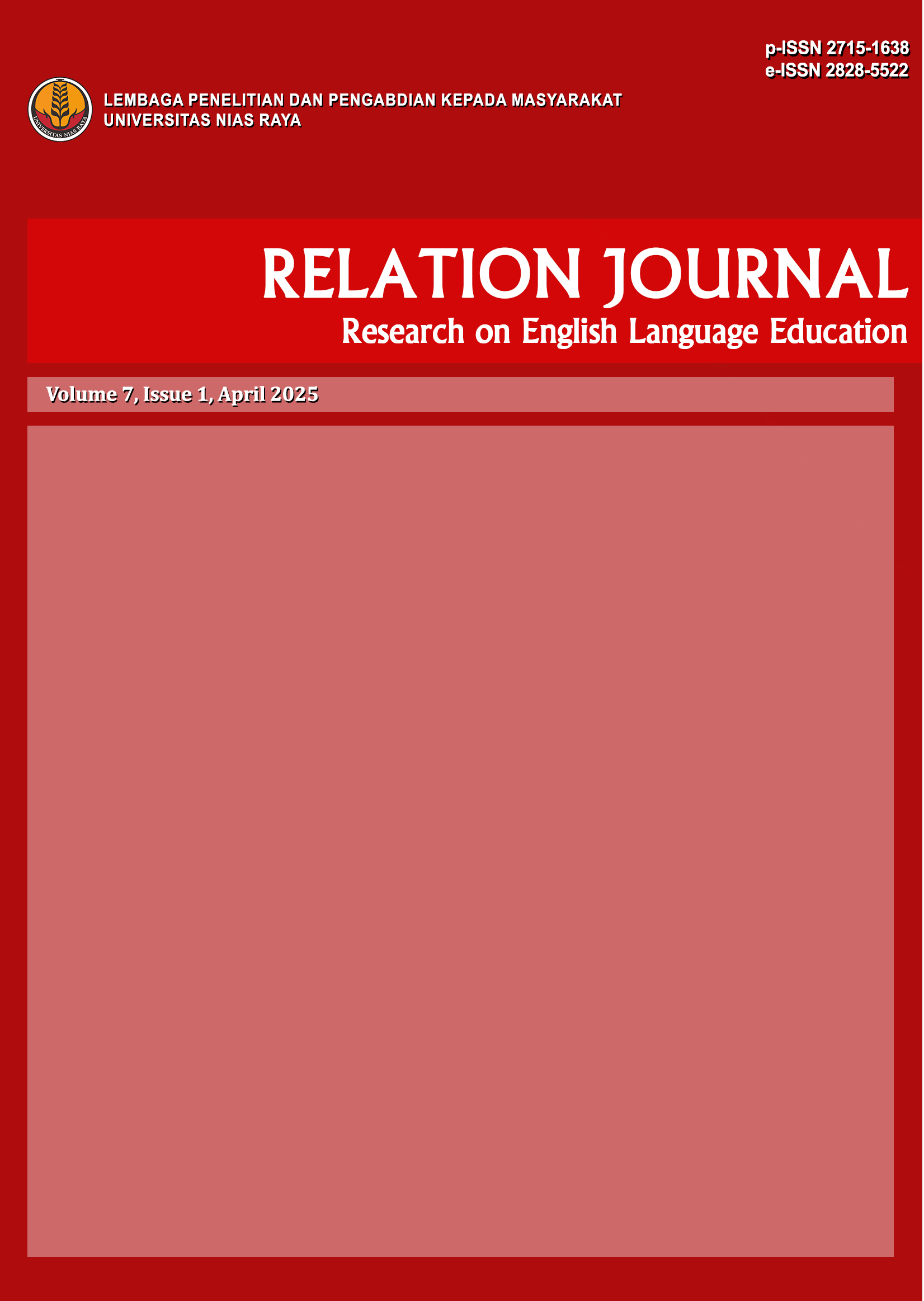AN ANALYSIS OF PROCLITICS AND ENCLITICS IN WEST NIAS LANGUAGE: A MORPHOSYNTACTIC STUDY
Abstract
This study examined the use of proclitics and enclitics in West Nias language from a morphosyntactic perspective. Using a descriptive qualitative approach supported by elicited linguistic data from native speakers, the analysis demonstrated that cliticization in West Nias was not merely a phonological attachment but also played an essential grammatical role in sentence structure. The results of this study indicated that the types of clitics found in West Nias language consist of proclitics, which attach to the beginning of a host word, and enclitics, which attach to the end of a host word. The proclitic forms identified in this language are a-, i-, ta-, ba-, ö-, u-, la-, and mi-o-, while the enclitic forms identified are -gu, -mö, -ma, -mi, -ra, and -nia. In West Nias, proclitics function as pronominal markers that indicate the actor and primarily attach to verbs, as well as to preverbal elements such as modals and certain prepositions. Enclitics attach to nouns to mark possession, and may also occur on verbs, adjectives, and adverbs when these elements function as the predicate. Therefore, proclitics in West Nias are pronominal because their presence corresponds with the subject of the clause.
References
Amir, M. (2024). Reconsidering the Dual Nature of Clitics: Between Words and Affixes. Journal of Theoretical Morphology and Syntax, 12(2), 55–72.
Creswell, J. W., & Creswell, J. D. (2023). Research Design: Qualitative, Quantitative, and Mixed Methods Approaches (6th ed.). SAGE Publications.
Creswell, J. W., & Creswell, J. D. (2023). Research Design: Qualitative, Quantitative, and Mixed Methods Approaches (6th ed.). SAGE Publications.
Fajriani Fitri. (2025). Compliment Speech Acts: Gender Representation And Self Image Of Jisoo Blackpink In Instagram Comment Sections. Research on English Language Education, 7(1), 1-15. https://doi.org/10.57094/relation.v7i1.256
Giawa, A. A. (2025). Students’ Problems In Speaking English Language At The Ninth Grade Of SMP Negeri 1 O’o’u. Research on English Language Education, 7(1), 16-26. https://doi.org/10.57094/relation.v7i1.2633
Harefa, D. (2025). Getting To Know Yahowu And Ya’ahowu Warm Greetings From The Nias Community. KOHESI : Jurnal Pendidikan Bahasa Dan Sastra Indonesia, 5(2), 15-27. https://doi.org/10.57094/kohesi.v5i2.2559
Harefa, D. (2025). Globalizing Hombo Batu The Role Of English In Promoting Nias Local Wisdom On The International Stage. Research on English Language Education, 7(1), 74-91. https://doi.org/10.57094/relation.v7i1.2638
Harefa, D. (2025). Mathematics As A Philosophical Foundation In Hombo Batu: Exploring Nias’ Local Wisdom Through The Perspective Of Mathematics. Afore : Jurnal Pendidikan Matematika, 4(1), 13-26. https://doi.org/10.57094/afore.v4i1.2557
Harefa, D. (2025). Student Character Education Based On Kinship And Solidarity Values Of Hombo Batu To Reduce Conflicts In Schools. Ndrumi : Jurnal Ilmu Pendidikan Dan Humaniora, 8(2), 61-74. https://doi.org/10.57094/ndrumi.v8i2.3921
Harefa, D. (2025). The Role Of Sofo-Sofo In Strengthening Health Awareness And Local Wisdom In Nias. Haga : Jurnal Pengabdian Kepada Masyarakat, 4(2), 12-26. https://doi.org/10.57094/haga.v4i2.3918
Harris, A. C., & Samuel, A. G. (2024). Processing and Production of Clitics in Udi and European Portuguese: Testing a Processing Account of an Extension of the Suffixing Preference. Journal of Linguistics (Cambridge University Press).
Haspelmath, M. (2023). Types of clitics in the world’s languages: Revisiting the affix–clitic distinction. Leipzig: Max Planck Institute for Evolutionary Anthropology.
Hyman, L., & Inkelas, S. (2022). The Morphophonology of Clitics. Annual Review of Linguistics, 8(1), 345–369.
Koshy, A. (2024). Re-evaluating Affixes and Clitics in Munda Multi-verb Constructions. Indian Journal of Language and Linguistics (IJLL).
Lase, F. (2025). Students’ Errors In The Use Of Simple Present Tense In Writing Descriptive Text At The Eleventh Grade Of SMA Negeri 1 Telukdalam. Research on English Language Education, 7(1), 27-37. https://doi.org/10.57094/relation.v7i1.2634
Loi, A. E. (2025). Illocutionary Acts Used In The Disney Movie The Good Dinosaur. Research on English Language Education, 7(1), 50-61. https://doi.org/10.57094/relation.v7i1.2636
Miles, M. B., Huberman, A. M., & Saldaña, J. (2024). Qualitative Data Analysis: A Methods Sourcebook (5th ed.). SAGE Publications.
Mukminin, M. S. (2025). Translation Techniques Of Garment Steamer Parts Terms In User Manual. Research on English Language Education, 7(1), 38-49. https://doi.org/10.57094/relation.v7i1.2576
Paltridge, B., & Phakiti, A. (2023). Research Methods in Applied Linguistics: A Practical Resource (2nd ed.). Bloomsbury Academic.
Zagoto, Sitasi. 2018. Variasi Bahasa Nias: Sebuah Kajain Dialektologi. Disertasi Tidak Diterbitkan. Medan: Fakultas Ilmu Budaya Universitas Sumatera Utara.
Copyright (c) 2025 Opirman Waruwu

This work is licensed under a Creative Commons Attribution-ShareAlike 4.0 International License.
You are free to:
- Share — copy and redistribute the material in any medium or format for any purpose, even commercially.
- Adapt — remix, transform, and build upon the material for any purpose, even commercially.
- The licensor cannot revoke these freedoms as long as you follow the license terms.
Under the following terms:
- Attribution - You must give appropriate credit , provide a link to the license, and indicate if changes were made . You may do so in any reasonable manner, but not in any way that suggests the licensor endorses you or your use.
- No additional restrictions - You may not apply legal terms or technological measures that legally restrict others from doing anything the license permits.
Notices:
- You do not have to comply with the license for elements of the material in the public domain or where your use is permitted by an applicable exception or limitation.
- No warranties are given. The license may not give you all of the permissions necessary for your intended use. For example, other rights such as publicity, privacy, or moral rights may limit how you use the material.









